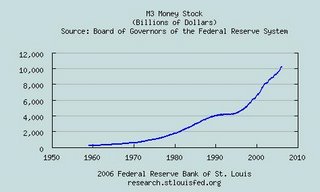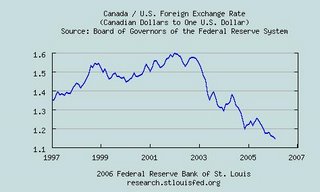It Will All Hit the Fan in 2007, Part 4
So the Fed ceased publication of the M3 money supply measurement last Thursday, March 23.
You might ask, "Why should we care?"
What you should ask is, "Why did they do it?"
According to the Fed:
"M3 does not appear to convey any additional information about economic activity that is not already embodied in M2 and has not played a role in the monetary policy process for many years."
I don't believe it.
Before I get into why, let's talk about money supply and M3.
The different measures of money supply are (thanks, Wikipedia!):
M0
The total of all physical currency, plus accounts at the central bank which can be exchanged for physical currency.
M1
M0 + the amount in demand accounts ("checking" or "current" accounts).
M2
M1 + most savings accounts, money market accounts, and certificate of deposit accounts (CDs) of under $100,000.
M3
M2 + all other CDs, deposits of eurodollars and repurchase agreements.
It's obvious from the above definition that M3 is the broadest measurement of how much U.S. money exists in the world. (Eurodollars are U.S. dollars on deposit in non-U.S. banks. Our massive trade deficit is causing the supply of overseas U.S. dollars to skyrocket.)
The new Fed chairman, Ben Bernanke, has admitted "U.S. dollars have value only to the extent that they are strictly limited in supply."
The corollary of that statement is, the value of the dollar will go down if dollar supply increases.
And M3 money supply has grown precipitously in the past 6 years (as shown in the graph below).

And what's happened to the value of the dollar in the past 6 years?
Surprise, surprise, as M3 has increased, the dollar has lost value against all major currencies (this graph shows dollar weakness relative to the Canadian dollar).

As the dollar loses value, inflation rears its ugly head. And the Fed has admitted they are afraid of inflation, as proven by their 15 consecutive rate hikes. Yet, at the same time, they try to convince us inflation is low by using their "core CPI" measurement that excludes food and energy costs.
So why would the Fed discontinue M3?
In my opinion, the Fed is afraid. They know we have to fund our massive budget and trade deficits. The easiest way to manage these deficits is by devaluing the dollar. The Fed can devalue the dollar by increasing dollar supply.
M3 money supply is the easiest way to track dollar supply growth.
But, oops! Now it's gone. We can no longer see what those pesky Feds are doing to our M3.
Hmmm ... it all sounds pretty fishy to me ...
Coming soon, Part 5!
Here are links to the earlier parts of this post:
Part 1, Part 2, Part 3

0 Comments:
Post a Comment
<< Home